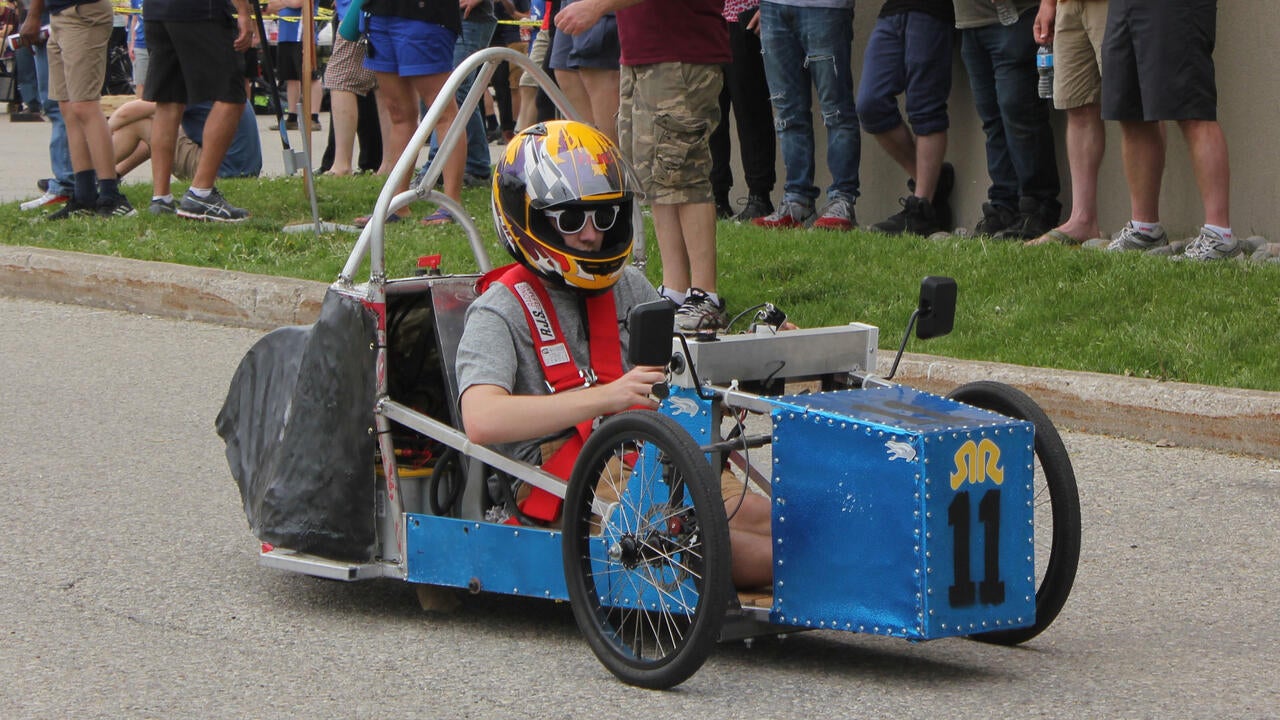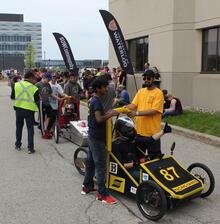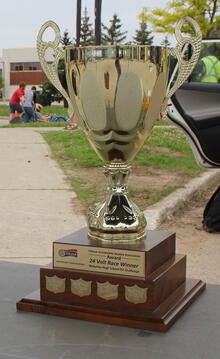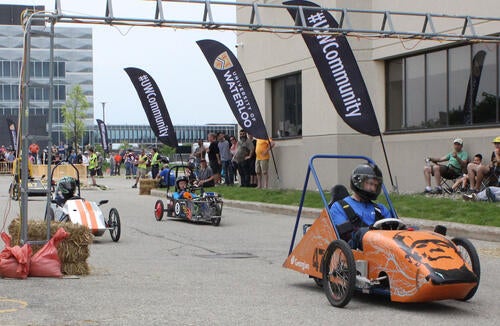
Fixing flats and pumping tires all part of the EV Challenge
Student teams combine engineering theory, hands-on learning and whatever else it takes to race their electric cars.

Student teams combine engineering theory, hands-on learning and whatever else it takes to race their electric cars.
By Brian Caldwell Faculty of EngineeringAlex Cattran was up for anything when 17 student teams gathered Saturday to race against each other - and test themselves in the process - in electric cars they had spent months designing and building.
 In addition to driving the entry from Guelph Collegiate and Vocational Institute, he worked in the pits furiously pumping up a leaky tire and scrambling to find replacements for a part that kept falling off.
In addition to driving the entry from Guelph Collegiate and Vocational Institute, he worked in the pits furiously pumping up a leaky tire and scrambling to find replacements for a part that kept falling off.
“I’m kind of the man who’s there when any job needs to be done,” said Cattran, 17.
Doing whatever it takes was a key strategy as the University of Waterloo hosted its seventh Waterloo Electric Vehicle (EV) Challenge for high school and college teams in Ontario.
Completing as many laps as possible in 12-volt and 24-volt endurance races on a temporary track on the East Campus required teamwork and perseverance as much as technical know-how.
Zac Harvie, 18, also got a workout on a manual bicycle pump when his Ottawa-area team’s car blew out both front tires in the late stages of the final race.
“I was cranking it as hard as I possibly could,” said Harvie. “It’s not fun, but it has to be done to get it back out on the track.”
The annual event challenges students to design and build battery-powered, three-wheeled cars capable of racing at speeds of about 30 km/h for up to 75 minutes.
It has grown steadily since its first running in 2012 as students get hooked on the marriage of classroom theory and a hands-on project, plus related skills like beating the bushes for sponsors and designing team T-shirts.
 Cattran has been involved since his high school first formed a team three years ago.
Cattran has been involved since his high school first formed a team three years ago.
“We aren’t just making projects in class like hammers or gyro discs,” he said. “We actually make cars and race them, so we feel like we’re really accomplishing something - and racing a car is pretty cool.”
Harvie, who estimated he put in 120 hours of work on his team’s car prior to race day, had the same take after his first year of participation. Even failing to finish didn’t dampen his enthusiasm much.
“I’m a huge fan,” he said. “It’s an absolute blast because you make something you can actually sit in and drive.”
Although his team didn’t make it to the podium, Cattran only had one regret.
“I wish I could keep doing it, but I’m graduating this year, unfortunately,” he said.
Attended by hundreds of parents and other spectators, the event wrapped up with awards for excellence in engineering, the best first-year team and the top three finishers in two race categories.
The 12-volt winners were Bluevale Collegiate Institute of Waterloo, Our Lady of Lourdes Catholic High School of Guelph and Martingrove Collegiate Institute of Etobicoke.
The top 24-volt cars were from Bluevale, Our Lady of Lourdes and St. Mary’s High School of Kitchener. Bluevale earned a free trip to the Canadian International AutoShow in Toronto, where its car will be on display.


Read more
Waterloo Engineering community honours impact and innovation at annual awards dinner

Read more
Meet five exceptional Waterloo graduate students crossing the convocation stage as Class of 2025 valedictorians

Read more
Twenty-six researchers receive federal funding to drive discovery, innovation and research infrastructure development
Read
Engineering stories
Visit
Waterloo Engineering home
Contact
Waterloo Engineering
The University of Waterloo acknowledges that much of our work takes place on the traditional territory of the Neutral, Anishinaabeg, and Haudenosaunee peoples. Our main campus is situated on the Haldimand Tract, the land granted to the Six Nations that includes six miles on each side of the Grand River. Our active work toward reconciliation takes place across our campuses through research, learning, teaching, and community building, and is co-ordinated within the Office of Indigenous Relations.